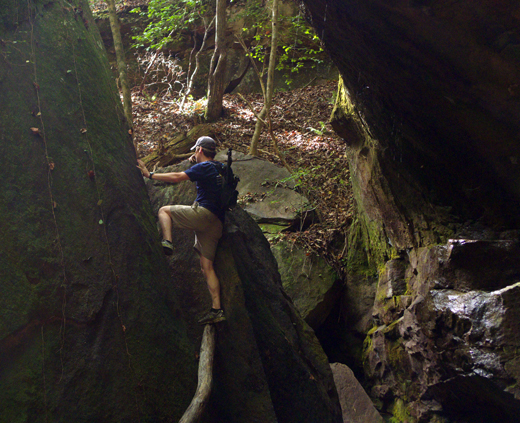The building now known as the Pythian Temple of Alabama was built in 1913 for the Alabama Penny Savings Bank, the first bank in Alabama to be owned by a black resident; additionally, the Alabama Penny Savings Bank, founded by William Reuben Pettiford, became the second largest black-owned bank in the United States. The Penny Savings Bank, in operation from 1890 to 1915, was a staple of the black
community in Birmingham. The bank provided mortgages and business loans
for many residents of Smithfield and other Birmingham areas, who were
unable to procure loans elsewhere.
 The Pythian Temple building was designed by Wallace A. Rayfield, who was also the architect behind the 16th Street and 22nd Avenue Baptist Churches, among other buildings. In addition to the indelible mark his architecture has left on Birmingham, Rayfield taught at Tuskegee Institute under Booker T. Washington, and designed buildings elsewhere in the South. More about Rayfield can be found in the biography of the man and his work: The Architectural Legacy of Wallace A. Rayfield: Pioneer Black Architect of Birmingham, Alabama.The Windham Construction Co., also with black ownership, was contracted to erect the building; the Windham brothers, Thomas and Benjamin, had previously collaborated with Rayfield on the 16th Street Baptist Church, among other projects.
The Pythian Temple building was designed by Wallace A. Rayfield, who was also the architect behind the 16th Street and 22nd Avenue Baptist Churches, among other buildings. In addition to the indelible mark his architecture has left on Birmingham, Rayfield taught at Tuskegee Institute under Booker T. Washington, and designed buildings elsewhere in the South. More about Rayfield can be found in the biography of the man and his work: The Architectural Legacy of Wallace A. Rayfield: Pioneer Black Architect of Birmingham, Alabama.The Windham Construction Co., also with black ownership, was contracted to erect the building; the Windham brothers, Thomas and Benjamin, had previously collaborated with Rayfield on the 16th Street Baptist Church, among other projects.
In 1915, the Knights of Pythias purchased the building for $70,000, and it became a social hub in the city. The Knights of Pythias are a fraternal order, with a very distinguished heritage including the following members: William Jennings Bryan, Justice Hugo Black, Louis Armstrong, and Presidents Warren G. Harding and Franklin D. Roosevelt. The order was established in 1864 by Justus Rathbone, who had an eye toward healing the Union once the Civil War came to an end.
[Do not be fooled by the apparent authenticity of the owls. They are
plastic and were manufactured in Knoxville, Tennessee in 1990.]
A.G. Gaston purchased the Pythian Temple and other neighboring buildings later in the 20th Century to house his various Booker T. Washington Corporation subsidiaries. In 1980, the National Register of Historic Places added the building to its books.
Offices of A.G. Gaston
Many renovations later, the Pythian Temple of Alabama is little more than an office building with an old foundation and a largely forgotten history. Very little is left that could indicate the building's past importance to a large segment of Birmingham's populace.
[Left: Elevator Room Right: The very eery Basement]
____________________________________________________
Sources: Nancy C. Curtis, Black Heritage Sites: An African American Odyssey and Finder's Guide, 1996 <http://books.google.com/books?id=Rk7NPRm_nB0C&printsec=frontcover#v=onepage&q&f=false>; Rebecca Dobrinski, "Investing in the Past: The Pythian Temple," Magic City Post, 14 August 2011 <http://magiccitypost.com/2011/08/14/investing-in-the-past-the-pythian-temple/>;Chianti C. Legget, "A Fight to Maintain, Propel Birmingham's African American Heritage," The Birmingham Times, 22 December 2010 <http://www.birminghamtimesonline.com/site/index.php?option=com_content&view=article&id=4484%3Aa-fight-to-maintain-propel-birminghams-african-american-heritage&catid=35%3Alocal-news-headlines&Itemid=95&showall=1>; "Pythian Temple of Alabama," Emporis, <http://www.emporis.com/application/?nav=building&lng=3&id=pythiantempleofalabama-birmingham-al-usa>; John Sledge, "Southern Bound: An Overdue Look at Architect Wallace Rayfield," al.com, 12 August 2010 <http://blog.al.com/entertainment-press-register/2010/08/southern_bound_an_overdue_look.html>; Wilson Fallin, Jr. "Penny Savings Bank of Birmingham," Encyclopedia of Alabama, Updated 13 May 2011 <http://www.encyclopediaofalabama.org/face/Article.jsp?id=h-1828>. 

















































